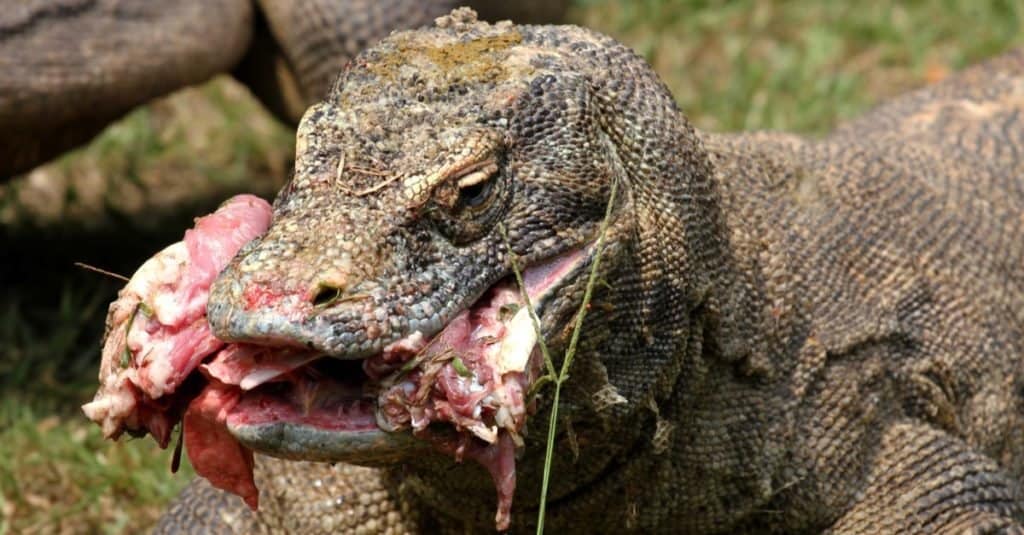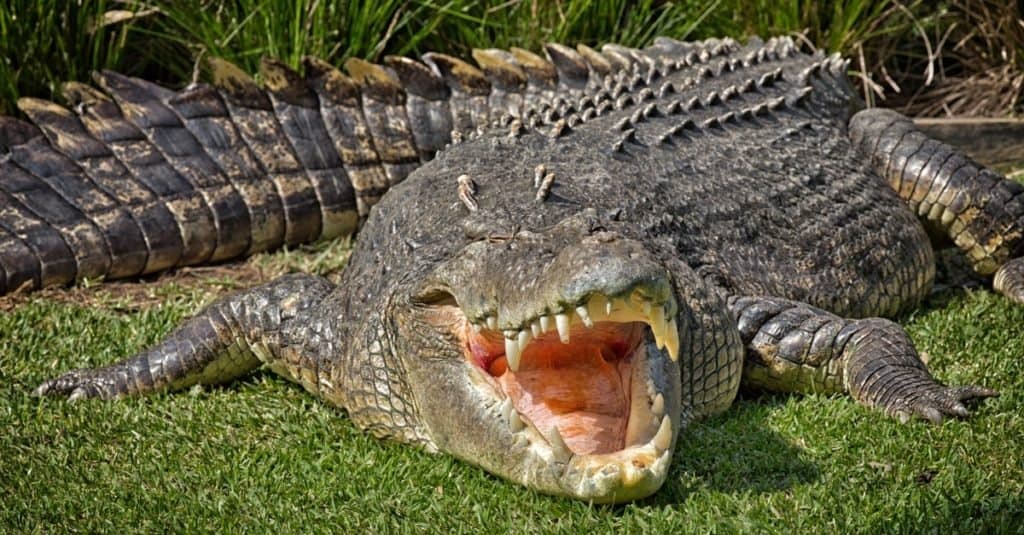Komodo dragons and tigers both live in parts of Asia. Each of them is feared for its ability to stalk and attack its prey, including humans! As such, it’s only fair to wonder what would happen if a tiger and a Komodo dragon fought each other. A Komodo dragon vs tiger fight could take place since their habitats overlap in Indonesia, a place where a few hundred wild tigers still roam.
We will examine the two animals and show you what would likely happen if the fierce mammal and deadly reptile got into a fight to the death!
Comparing a Komodo Dragon and a Tiger

| Komodo Dragon | Tiger | |
| Size | Weight: 150lbs – 300lbs Height: 1.5ft-2ft Length: 6ft-10ft | Weight: 500lbs – 660lbs Height: 3ft – 4ft at shoulder Length 8ft – 12.5ft |
| Speed and Movement Type | 11 mph top speed | 30-40 mph – Galloping run – 20ft -25ft leap |
| Senses | – Good eyesight – Use their tongues and Jacobson’s organ to smell and taste their environment and find prey from miles away – Poor hearing | – Profound sense of hearing helps tigers identify prey – Binocular vision is similar to humans but much better at night. – Sense of smell comparable to a dog |
| Defenses | – Hard skin with strong scales that are reinforced with bony deposits called osteoderms – Speed | – Massive size – Powerful roar – Striped fur camouflage helps tigers blend into their surroundings. |
| Offensive Capabilities | – Possibly venomous – Sharp claws hold prey in place – Sharp teeth lead to exsanguination in victims | – 4-inch claws that can kill prey – Powerful bite – Strong jaws that allow tigers to clamp down and suffocate prey – Tremendous muscle strength that helps them overwhelm prey |
| Predatory Behavior | – Ambush predators – Tries to knock down and bite vital areas on prey, typically the neck. | – Ambush predator – Stalks and attacks in favorable conditions – Seeks to clamp on prey’s neck to deliver a fatal bite. |
What Are Key Differences Between a Komodo Dragon and a Tiger?

Tigers are deadly mammals that use their claws and teeth to kill.
©iStock.com/BreakingTheWalls
The most significant differences between Komodo dragons and tigers are their morphology and size. Tigers are larger than Komodo dragons, and they’re quadrupedal mammals with fur coats, while Komodo dragons are quadrupedal reptiles with reinforced scaly skin.
Both animals can be found in Indonesia, but the tiger also lives in other parts of the world stretching far west to India and as far north as Russia. However, both creatures are endangered, so their numbers aren’t very high in the wild.
We’re going to explore these differences in greater depth so we can better understand which of these animals has the highest chance of winning a battle.
What Are the Key Factors in a Fight Between a Komodo Dragon and a Tiger?

Komodo dragons use their vicious bites to win battles against larger creatures.
©Yudi S/Shutterstock.com
Every fight in the animal kingdom comes down to a handful of factors such as the combatants’ size, speed, and ferocity. We’re going to explore several facets of these animals, including how they fight. By figuring out what advantages these creatures have over their opponent, we’ll be able to determine who will win this fight.
Komodo Dragon vs Tiger: Size
Tigers are larger than Komodo dragons overall. Not only do tigers stand up to 4 feet at the shoulder compared to a Komodo dragon’s 2 feet, but also they weigh upwards of 600 pounds and grow 12 feet long! Komodo dragons only weigh about 300 pounds and grow 10 feet long.
In summary, Komodo dragons are very large, powerful animals, but they are about half the size of a fully grown tiger.
Tigers have an advantage in terms of size.
Komodo Dragon vs Tiger: Speed and Movement
A Komodo Dragon is slower than a tiger. These lizards move at only 11 mph. While that is fast for a reptile, it’s not nearly as fast as a tiger. The fastest tigers can reach speeds of 30-40 mph, and they can end that sprint with a 20-ft leap onto their prey.
Tigers have a serious speed advantage.

The Komodo Dragon has a specialty sensory organ that allows it to flick its tongue to gather information about its surroundings.
©iStock.com/photomaru
Komodo Dragon vs Tiger: Senses
Both Komodo dragons and tigers are predators that excel at hunting other creatures. Tigers have amazing hearing, good vision that gets better at night, and a sense of smell that is about as good as a dog’s.
Komodo dragons have good eyesight and bad hearing. However, they find a lot of their prey by using their senses of smell and taste. They have a specialty sensory organ called the Jacobson’s organ, and it allows them to flick their tongue to gather information about their surroundings. This super sense lets them find prey all around their environment.
Komodo dragons have a slight edge in terms of their sensory abilities.
Komodo Dragon vs Tiger: Physical Defenses
Tigers have many defenses, including their massive size, terrifying threat display, camouflage, and speed that allow them to outpace nearly anything in their territory.
Komodo dragons are good at hiding in alcoves on their islands, have osteoderms along their scales to prevent biting attacks, and can scamper away on land and swim well in water.
Tigers have better defenses.
Komodo Dragon vs Tiger: Combat Skills
Komodo dragons have powerful combat abilities. They ambush their prey, trying to knock them off their feet while going for a deadly bite on their necks or other vital areas. Their 60 teeth are serrated and sharp, capable of inflicting grievous wounds on whatever they bite.
Komodo dragons have a unique sort of venom that is delivered through teeth. Secreted along with their saliva, the venom seems to have anticoagulant properties and can irritate the flesh where it’s introduced.
Apart from their ripping teeth, Komodos also have a unique technique in biting and ripping their victim’s flesh off. Komodo dragons use a customized bite-and-pull strategy when biting prey or attacking humans. They do this using their powerful neck muscles that aid them in taking a forceful bite.
In a frenzied attack, Komodo dragons will bite an animal, or sometimes humans, and pull back the flesh while oozing the venom from their mouth into the victim’s gaping wound . The venom quickens the blood loss process and sends the victim into lethargy or shock.
Tigers are expert ambush predators, and they are much more straightforward with their attacks. They will ambush their prey from dense brush, using their weight to pin prey and their 4-inch claws to dig in. At the same time, they can drive their long teeth into their prey, biting deep into their head, necks, and other areas. Knowing this, we can form an idea of how a fight between the creatures would occur.
Who Would Win in a Fight Between a Komodo Dragon and a Tiger?

A tiger is too much for a Komodo dragon to handle.
©enky03/Shutterstock.com
A tiger would win a fight against a Komodo dragon. An ambush by the tiger would instantly end a fight against a Komodo dragon, and the tiger would just as easily win a battle without the element of surprise. In fact, if it was attacked by the Komodo dragon from a hiding place, which is not likely, then it would turn the tables on the smaller, weaker animal.
Tigers are far too large, fast, and powerful for a Komodo dragon to overcome. The tiger’s claws might not cut as deeply into the lizard’s flesh as they would a mammal, but their teeth would sink in far enough to deal serious damage or outright kill the Komodo dragon.
In fact, the raw power of a tiger might ensure the Komodo dragon doesn’t land a single blow against the big cat. If the lizard did land a bite, though, the tiger would certainly be in some serious pain after it was finished eating.
What Animal Can Take Down a Tiger?

Saltwater crocodiles have the largest bite force per square inch of any living creature
©PomInOz/Shutterstock.com
The Saltwater Crocodile: It would take a supremely bulky predator with the ability to lurk unseen and thus strike with the element of surprise, to be able to take down Asia’s apex predator. The saltwater crocodile seems to fit the bill perfectly with its ability to grow to 20 feet in length and tip the scales at 2,430 lb. Compared to the tiger’s maximum weight potential of 660 lbs, it is clear that the reptile dwarfs the wild feline in terms of mass.
And that’s just the beginning. The saltie’s bite force is quite simply the largest on the planet at 3,700 psi and is over thrice that of the tiger’s which is 1,050 psi. All it would take would be for a rather parched tiger to approach the bank of a river, and lose itself in the comfort of a cooling drink, unaware of the hooded gaze of a croc lurking no more than a few feet away. And then the startling speed of attack following which those powerful teeth would clamp on the tiger’s neck, and a forceful tug, to drag its prey beneath the surface.
The photo featured at the top of this post is © iStock.com/photomaru
Thank you for reading! Have some feedback for us? Contact the AZ Animals editorial team.






